DISTRICT 8 Caltrans Native Plant
workshop May 16, 2000
by Craig Dremann of the Reveg Edge.
Photos by Jonelle Malloy, copyright © 2000. These are the
local native plants we saw growing wild at the junction of I-215
and University Parkway, which have potential for use along roadsides
for landscaping and mitigation sites.
Text copyright © 2000 by Craig Dremann, Box 361, Redwood
City, CA. 94064 (650) 325-7333
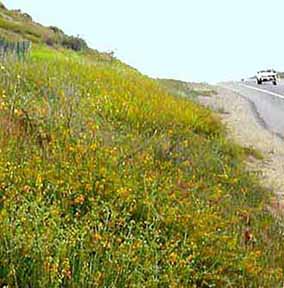
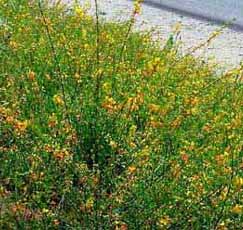
Lotus procumbens, a native perennial legume about 2 feet tall,
makes a fine display along the roadside, and was self-maintaining
and almost weed-free without any mowing or spraying. There are
thirty species of native Lotus in California, each with a great
potential for landscaping.
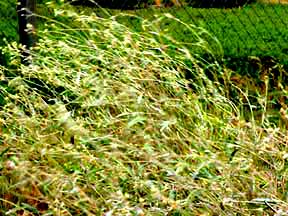 The perennial
native Croton californica, makes a beautiful gray border above
the Lotus, and this area was also weed-free without any mowing
or spraying.
The perennial
native Croton californica, makes a beautiful gray border above
the Lotus, and this area was also weed-free without any mowing
or spraying.
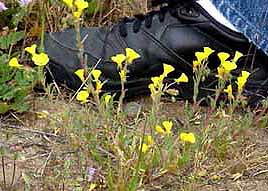 The tiny
Sun cups (Camissonia sp.) add color.
The tiny
Sun cups (Camissonia sp.) add color.
There are 64 different kinds of this beautiful, low-growing
species in California.

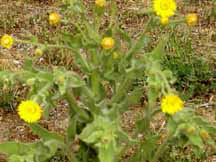
The showy Golden Aster (Heterotheca grandiflora) was beginning
to bloom. Plants flower from summer until frost, and they are
able to colonize disturbed soil faster than the exotic weeds in
the drier Coast Ranges of California.
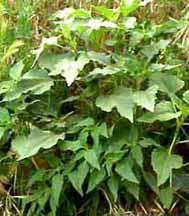
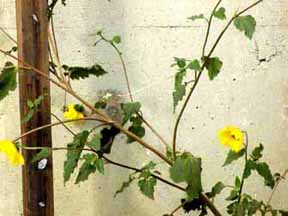
The wild native sunflower (Helianthus annuus), which is
the wild ancestor to the cultivated sunflower, also blooms throughout
the summer until frost, and is able to keep weeds out by releasing
herbicide-like chemicals called "allelochemicals". Plants
grow principally at old Native American village sites in California.
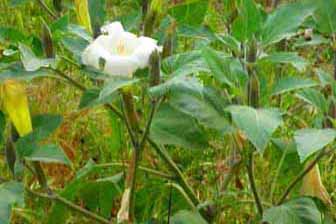 The showy perennial
Datura wrightii, which also has the ability to keep weeds
away, as the plants release natural herbicide-like chemicals.
Our largest wildflower about 8 inches long and four inches across,
white and light lavender, blooms all summer without water.
The showy perennial
Datura wrightii, which also has the ability to keep weeds
away, as the plants release natural herbicide-like chemicals.
Our largest wildflower about 8 inches long and four inches across,
white and light lavender, blooms all summer without water.
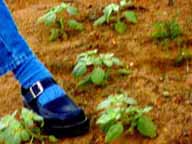
 And finally,
the two most forgotten and overlooked native plants along our
California roadsides. The photo on the left is of the Turkey
Mullien (Eremocarpus setigerus), which could take the place
of the exotic tumbleweed, especially along I-5 in San Joaquin
county. This plant thrives along the sprayed road edge, and a
little management could make it an important low-growing, fire
resistant edge-plant. Plants are shown at their maximum height.
And finally,
the two most forgotten and overlooked native plants along our
California roadsides. The photo on the left is of the Turkey
Mullien (Eremocarpus setigerus), which could take the place
of the exotic tumbleweed, especially along I-5 in San Joaquin
county. This plant thrives along the sprayed road edge, and a
little management could make it an important low-growing, fire
resistant edge-plant. Plants are shown at their maximum height.
HONORABLE MENTION: THE NATIVE PERENNIAL GRASSES that should
have been present. The drawing on the right shows probably
what originally grew in the junction of I-215 and University Parkway,
one of the Stipas (Nassella cernua), one of California's
"bunchgrasses" that are pictured on the State flag under
the Grizzly Bear. These grasses stay green at the base all summer
without irrigation, and are usually under eight inches tall. Perennial
native grasses would be a very important vegetation component
to include in any future roadside management plans.
Botanical
names on this page is from the Jepson Manual edited by Hickman,
University of California Press, 1995. The bunchgrass drawing is
from Abrams' Illustrated Flora of the Pacific States, Stanford
Univ. Press, four volumes.
The plants shown on this page are only eight examples from
the over 5,000 California native plants that are available for
landscaping our roadsides. If you want to learn more about the
local native plants of your area and how to utilize and manage
them for your roadsides, you can call me:
(650) 325-7333 and check out our workshop page for DOTs at http://www.ecoseeds.com/workshop.html
Updated December 20, 2022 - Go to The
Reveg Edge website


 The perennial
native Croton californica, makes a beautiful gray border above
the Lotus, and this area was also weed-free without any mowing
or spraying.
The perennial
native Croton californica, makes a beautiful gray border above
the Lotus, and this area was also weed-free without any mowing
or spraying. The tiny
Sun cups (Camissonia sp.) add color.
The tiny
Sun cups (Camissonia sp.) add color.



 The showy perennial
Datura wrightii, which also has the ability to keep weeds
away, as the plants release natural herbicide-like chemicals.
Our largest wildflower about 8 inches long and four inches across,
white and light lavender, blooms all summer without water.
The showy perennial
Datura wrightii, which also has the ability to keep weeds
away, as the plants release natural herbicide-like chemicals.
Our largest wildflower about 8 inches long and four inches across,
white and light lavender, blooms all summer without water.
 And finally,
the two most forgotten and overlooked native plants along our
California roadsides. The photo on the left is of the Turkey
Mullien (Eremocarpus setigerus), which could take the place
of the exotic tumbleweed, especially along I-5 in San Joaquin
county. This plant thrives along the sprayed road edge, and a
little management could make it an important low-growing, fire
resistant edge-plant. Plants are shown at their maximum height.
And finally,
the two most forgotten and overlooked native plants along our
California roadsides. The photo on the left is of the Turkey
Mullien (Eremocarpus setigerus), which could take the place
of the exotic tumbleweed, especially along I-5 in San Joaquin
county. This plant thrives along the sprayed road edge, and a
little management could make it an important low-growing, fire
resistant edge-plant. Plants are shown at their maximum height.